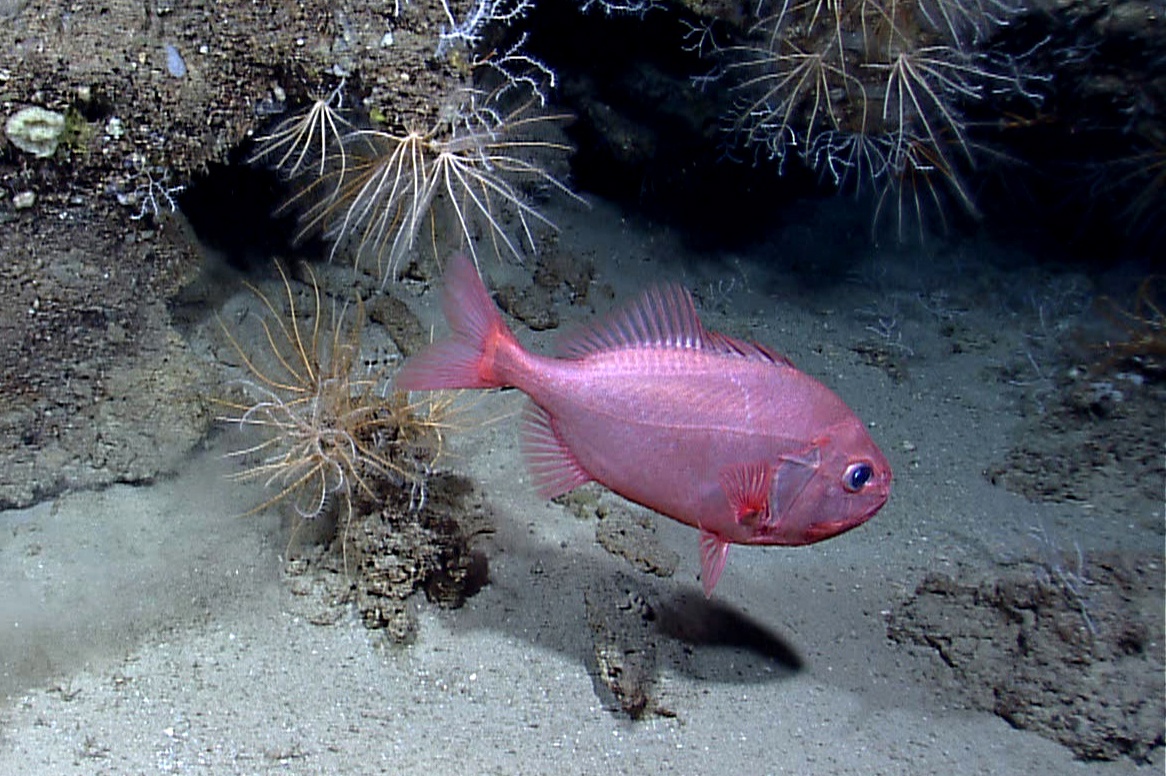Darwin's Roughy, Gephyroberyx darwinii (Johnson 1866)

Darwin's Roughy, Gephyroberyx darwinii, on a deep-sea coral reef in the northern Gulf of Mexico. Source: NOAA Office of Ocean Exploration and Research. License: Public Domain
Video of Darwin's Roughy at Echo Seamount, on the Sahara Seamount chain off the Canary Islands, Atlantic Ocean - depth about 450 m.
Darwin's Roughy, Gephyroberyx darwinii (Johnson 1866)
More Info
|
Distribution |
South of Saumarez Reef, Coral Sea, southwards around Tasmania, to northwest of Rowley Shoals, Western Australia; also Macquarie Island in the Southern Ocean. Elsewhere, the species is circumglobal in tropical, subtropical and temperate waters. Individuals or groups are benthopelagic over hard bottoms on the continental slope, ridges and rises, sometimes in association with deep-sea corals. |
|
Features |
Dorsal fin VIII, 13; Anal fin III, 11; Caudal fin 19; Pectoral fin 14; Pelvic fin I, 6; Lateral line scales 27. Body deep (45-53% SL), oval, sides compressed and flat. Head large (35-44% SL), eyes moderately large (30-41% HL), mouth large, angled obliquely, reaching beyond eye. Opercle with a prominent spine extending beyond posterior edge; spines also present at corner of preopercle, at origin of lateral line and on nasal bone. Mucous cavities on head shallow, covered by thick skin. Scales small, ctenoid, firmly attached; lateral line nearly straight, each scale slightly larger than surrounding body scales, with a small flat triangular spine on centrally on each scale; about 11 or 12 strong scutes on belly. Anus immediately preceding anal fin. Single dorsal fin with base of moderate length, spines smooth, strong, third to fifth longer than those before and after, soft rays noticeably longer than spines, of nearly uniform length; anal fin with short base, located below rear of dorsal fin; margins of soft dorsal and anal fins nearly straight; caudal fin forked. Pelvic fins arising below pectoral-fin base. |
|
Colour |
Head deep red to rosy; back pale red to brownish red; lower portions of sides silvery, sometimes with red; fins red in large fish, tipped with black in young. |
|
Feeding |
Feeds on mesopelagic crustaceans, small fishes and squid. |
|
Species Citation |
Trachichthys darwinii Johnson, 1866, Proc. Zool. Soc. London, 1866: 311, pl. 32. Type locality: Madeira. |
|
Author |
Bray, D.J. 2018 |
|
Resources |
Darwin's Roughy, Gephyroberyx darwinii (Johnson 1866)
References
Gomon, M.F. 1994. Families Trachichthyidae, Monocentridae. pp. 399-412 figs 358-369 in Gomon, M.F., Glover, C.J.M. & Kuiter, R.H. (eds). The Fishes of Australia's South Coast. Adelaide : State Printer 992 pp. 810 figs.
Gomon, M.F. 2008. Family Trachichthyidae. pp. 420-430. in Gomon. M.F., Bray, D.J. & Kuiter, R.H (eds). Fishes of Australia's Southern Coast. Sydney : Reed New Holland 928 pp.
Iwamoto, T. 2015. Gephyroberyx darwinii. The IUCN Red List of Threatened Species 2015: e.T16449531A16509807. http://dx.doi.org/10.2305/IUCN.UK.2015-4.RLTS.T16449531A16509807.en. Downloaded on 05 May 2018.
Johnson, J.Y. 1866. Description of Trachichthys darwinii, a new species of berycoid fish from Madeira. Proceedings of the Zoological Society of London 1866: 311-315 pl. 32
Kotlyar, A.N. 1996. Beryciform fishes of the world oceans. Moscow, VNIRO Publishing, 368 pp. [in Russian].
Maul, G.E. 1986. Trachichthyidae, in Whitehead, P.J.P., Bauchot, M.-L., Hureau, J.-C. & Tortonese, E. (eds) Fishes of the North-eastern Atlantic and the Mediterranean. Paris : UNESCO Vol. 2 pp. 517-1007.
May, J.L. & Maxwell, J.G.H. 1986. Field Guide to Trawl Fish from Temperate Waters of Australia. Hobart : CSIRO Division of Marine Research 492 pp.
Merrett, N.R. & Wheeler, A. 1983. The correct identification of two trachichthyid fishes (Pisces, Berycomorphi) from the slope fauna west of Britain, with notes on the abundance and commercial importance of Hoplostethus atlanticus. Journal of Natural History 17(4): 569-573.
Moore, J.A. & Paxton, J.R. 1999. Family Trachichthyidae. pp. 2215-2217 in Carpenter, K.E. & Niem, T.H. (eds). The Living Marine Resources of the Western Central Pacific. FAO Species Identification Guide for Fisheries Purposes. Rome : FAO Vol. 4 2069-2790 pp.
Woods, L.P. & Sonoda, P.M. 1973. Order Berycomorphi (Beryciformes). In, Cohen, D.M. (ed.) Fishes of the western North Atlantic. Memoir. Sears Foundation of Marine Research 1(6): 263-396 figs 1-66
Yearsley, G.K., Last, P.R. & Ward, R.D. (eds) 1999. Australian Seafood Handbook. Hobart : CSIRO Marine Research 460 pp.











